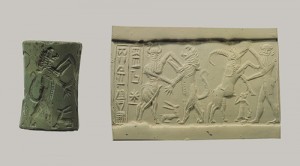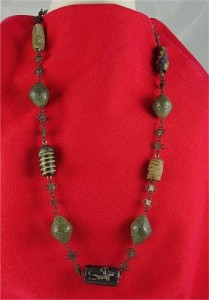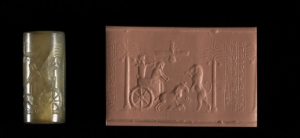Cylinder seals were used by the ancient Mesopotamians to press cuneiform writing onto clay tablets and were the precursor to moveable type. They were invented around 3500 BC in the city of Susa, what is now modern day southwest Iran. The cylinders were used as an administrative tool for officiating documents. A person’s seal was a kind of signature that they would use to signify personal items and business transactions. Many would wear their seal as jewelry or magical amulets.
Seals were usually made from gems or hard-stone because they were common materials found in the Fertile Crescent. However, there have been seals found made out of glass and ceramic materials as well. Most seals have a hole running through the center of the body which is how we know people used to wear them as necklaces. It is typical for seals to be about one inch in length and to contain engraved characters.
The images depicted on the seals are usually theme-driven or religious in nature. A famous cylinder depicting Darius I of Persia shows the king aiming a drawn bow at a charging lion, while his chariot horse is trampling a deceased lion. The scene is framed by trees and cuneiform text and contains the Faravahar symbol of Ahura Mazda, the god of Zoroastrianism.




Leave a response